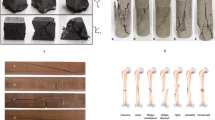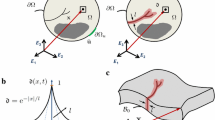Abstract
This paper investigates the effects of plasticity on the effective fracture toughness. A layered material is considered as a modelling system. An elastic-plastic phase-field model and a surfing boundary condition are used to study how the crack propagates throughout the material and the evolution of the effective toughness as a function of the layer angle. We study three idealized situations where only one of the properties among fracture toughness, Young’s modulus and yield strength is taken to be heterogeneous and the others are assumed to be uniform. We observe that in the case of toughness and strength heterogeneity, the material exhibits anomalous isotropy: the effective toughness is equal to the largest of the point-wise values for any layer angle except when the layers are parallel to the macroscopic direction of propagation. As the layer angle decreases, the crack propagates along the brittle-to-tough interfaces, whereas it goes straight when the layers have different yield strength but uniform toughness. We find that smooth deflections in the crack path do not induce any overall toughening and that the effective toughness is not proportional to either the cumulated fracture energy or the cumulated plastic work. In the case of elastic heterogeneity, the material is anisotropic in the sense of the effective toughness, as the latter varies as a function of the layer angle. Four toughening mechanisms are active: stress fluctuations, crack renucleation, plastic dissipation and plastic blunting. Finally, we consider a layered medium comprised of compliant-tough-weak and stiff-brittle-strong phases, as it is the case for many structural composites. We observe a transition from an interface-dominated to a plasticity-dominated failure regime, as the phase constituents become more ductile. The material is anisotropic in the sense of the effective toughness.








Similar content being viewed by others
References
Alessi R, Marigo J-J, Vidoli S (2015) Gradient damage models coupled with plasticity: variational formulation and main properties. Mech Mater 80:351–367
Balay S, Abhyankar S, Adams M, Brown J, Brune P, Buschelman K, Dalcin LD, Eijkhout V, Gropp W, Kaushik D, Knepley M, May D, McInnes LC, Munson T, Rupp K, Sanan P, Smith B, Zampini S, Zhang H, Zhang H (2013) PETSc Users Manual Revision 3.4. Technical report, Argonne National Laboratory (ANL), Argonne, IL (United States)
Balay S, Brown J, Buschelman K, Gropp W, Kaushik D, Knepley M, McInnes L, Smith B, Zhang H (2013) PETSc/Tao: Home Page
Balay S, Gropp WD, McInnes LC, Smith BF (1997) Efficient management of parallelism in object-oriented numerical software libraries. In: Modern software tools for scientific computing. Birkhäuser Boston, Boston, pp 163–202
Barthelat F (2010) Nacre from mollusk shells: a model for high-performance structural materials. Bioinspir Biomim 5(3):035001
Benzerga AA, Leblond J-B, Needleman A, Tvergaard V (2016) Ductile failure modeling. Int J Fract 201(1):29–80
Beremin F (1981) Cavity formation from inclusions in ductile fracture of a508 steel. Metall Trans A 12(5):723–731
Bleyer J, Alessi R (2018) Phase-field modeling of anisotropic brittle fracture including several damage mechanisms. Comput Methods Appl Mech Eng 336:213–236
Bogy DB (1971a) On the plane elastostatic problem of a loaded crack terminating at a material interface. J Appl Mech 38(4):911–918
Bogy DB (1971b) Two edge-bonded elastic wedges of different materials and wedge angles under surface tractions. J Appl Mech 38(2):377–386
Bonderer LJ, Studart AR, Gauckler LJ (2008) Bioinspired design and assembly of platelet reinforced polymer films. Science 319(5866):1069–1073
Bourdin B (2019) mef90/vDef: variational models of defect mechanics. https://github.com/bourdin/mef90
Bourdin B, Francfort G, Marigo J-J (2000) Numerical experiments in revisited brittle fracture. J Mech Phys Solids 48(4):797–826
Bourdin B, Francfort GA, Marigo J-J (2008) The variational approach to fracture. J Elasticity 91(1–3):5–148
Bourdin B, Larsen CJ, Richardson CL (2011) A time-discrete model for dynamic fracture based on crack regularization. Int J Fract 168(2):133–143
Bower AF, Ortiz M (1991) A three-dimensional analysis of crack trapping and bridging by tough particles. J Mech Phys Solids 39(6):815–858
Brach S, Hossain M, Bourdin B, Bhattacharya K (2019a) Anisotropy of the effective toughness of layered media. J Mech Phys Solids 131:96–111
Brach S, Tanné E, Bourdin B, Bhattacharya K (2019b) Phase-field study of crack nucleation and propagation in elastic-perfectly plastic bodies. Comput Methods Appl Mech Eng 353:44–65
Braides A et al (1998) Approximation of free-discontinuity problems. Springer Science & Business Media, Berlin Number 1694
Budiansky B, Hutchinson JW, Evans AG (1986) Matrix fracture in fiber-reinforced ceramics. J Mech Phys Solids 34(2):167–189
Chambolle A, Francfort GA, Marigo J-J (2009) When and how do cracks propagate? J Mech Phys Solids 57(9):1614–1622
Cherepanov G (1967) Crack propagation in continuous media: PMM vol. 31, no. 3, 1967, pp. 476–488. J Appl Math Mech 31(3):503–512
Cook T, Erdogan F (1972) Stresses in bonded materials with a crack perpendicular to the interface. Int J Eng Sci 10(8):677–697
Dal Maso G (2012) An introduction to \(\Gamma \)-convergence, vol 8. Springer Science & Business Media, Berlin
Dal Maso G, Orlando G, Toader R (2016) Fracture models for elasto-plastic materials as limits of gradient damage models coupled with plasticity: the antiplane case. Calc Var Partial Differ Equ 55(3):45
Dal Maso G, Toader R (2020) On the jerky crack growth in elastoplastic materials. Calc Var Partial Differ Equ 59(4):1–40
Descatha Y, Ledermann P, Devaux J, Mudry F, Pineau A, Lautridou J (1981) Experimental and numerical study of the different stages in ductile rupture- application to crack initiation and stable crack growth. Three-dimensional constitutive relations and ductile fracture.(A 83-18477 06-39) Amsterdam, North-Holland Publishing Co., 1981, pp 185–205
Dimas LS, Giesa T, Buehler MJ (2014) Coupled continuum and discrete analysis of random heterogeneous materials: elasticity and fracture. J Mech Phys Solids 63:481–490
Dimas LS, Veneziano D, Giesa T, Buehler MJ (2015) Probability distribution of fracture elongation, strength and toughness of notched rectangular blocks with lognormal young’s modulus. J Mech Phys Solids 84:116–129
Djouda JM, Bouaziz MA, Zouaoui M, Rambaudon M, Gardan J, Recho N, Crépin J (2020) Experimental approach for microscale mechanical characterization of polymeric structured materials obtained by additive manufacturing. Polymer Testing, p 106634
Evans AG (1990) Perspective on the development of high-toughness ceramics. J Am Ceramic Soc 73(2):187–206
Faber KT, Evans AG (1983a) Crack deflection processes—i. theory. Acta Metallurgica 31(4):565–576
Faber KT, Evans AG (1983b) Crack deflection processes—ii. experiments. Acta Metallurgica 31(4):577–584
Francfort G, Marigo J-J (1998) Revisiting brittle fracture as an energy minimization problem. J Mech Phys Solids 46(8):1319–1342
Fratzl P, Gupta HS, Fischer FD, Kolednik O (2007) Hindered crack propagation in materials with periodically varying young’s modulus—lessons from biological materials. Adv Mater 19(18):2657–2661
Gao H, Rice JR (1989) A first-order perturbation analysis of crack trapping by arrays of obstacles
Gol’Dstein R, Salganik R (1974) Brittle fracture of solids with arbitrary cracks. Int J Fract 10(4):507–523
He MY, Hutchinson JW (1989) Crack deflection at an interface between dissimilar elastic-materials. Int J Solids Struct 25(9):1053–1067
Hossain MZ, Hsueh CJ, Bourdin B, Bhattacharya K (2014) Effective toughness of heterogeneous media. J Mech Phys Solids 71(1):15–32
Hsueh CJ, Avellar L, Bourdin B, Ravichandran G, Bhattacharya K (2018) Stress fluctuation, crack renucleation and toughening in layered materials. J Mech Phys Solids 120:68–78
Huajian G (1991) Fracture analysis of nonhomogeneous materials via a moduli-perturbation approach. Int J Solids Struct 27(13):1663–1682
Kobayashi T, Giovanola J (1989) Crack opening profile observations for dynamic cleavage crack propagation and arrest. J Mech Phys Solids 37(6):759–777
Krstic VD (1983) On the fracture of brittle-matrix/ductile-particle composites. Philos Mag A 48(5):695–708
Lancioni G, Alessi R (2020) Modeling micro-cracking and failure in short fiber-reinforced composites. J Mech Phys Solids 137:103854
Li J, Zhang X, Recho N (1997) Investigation of an arbitrarily oriented crack meeting. Eur J Mech A/Solids 16(5):795–821
Lynch SP, Moutsos S (2006) A brief history of fractography. J Fail Anal Prevent 6(6):54–69
Marigo J-J, Maurini C, Pham K (2016) An overview of the modelling of fracture by gradient damage models. Meccanica 51(12):3107–3128
Maso GD, Heltai L (2020) A numerical study of the jerky crack growth in elastoplastic materials with localized plasticity. arXiv preprint arXiv:2004.12705
Mills K, Authors A (1987) Metals handbook: Volume 12: Fractography (asm hand-book). ASM International, The Materials Information Society, The United States of America
Munch E, Launey ME, Alsem DH, Saiz E, Tomsia AP, Ritchie RO (2008) Tough, bio-inspired hybrid materials. Science 322(5907):1516–1520
Murali P, Bhandakkar TK, Cheah WL, Jhon MH, Gao H, Ahluwalia R (2011) Role of modulus mismatch on crack propagation and toughness enhancement in bioinspired composites. Phys Rev E 84(1):015102
Pham K, Marigo J-J (2010a) Approche variationnelle de l’endommagement: I. les concepts fondamentaux. Comptes Rendus Mécanique 338(4):191–198
Pham K, Marigo J-J (2010b) Approche variationnelle de l’endommagement: Ii. les modèles à gradient. Comptes Rendus Mécanique 338(4):199–206
Pham K, Marigo J-J, Maurini C (2011) The issues of the uniqueness and the stability of the homogeneous response in uniaxial tests with gradient damage models. J Mech Phys Solids 59(6):1163–1190
Pineau A, Benzerga AA, Pardoen T (2016) Failure of metals i: brittle and ductile fracture. Acta Materialia 107:424–483
Ravichandran K (1992) The mechanics of toughness development in ductile phase reinforced brittle matrix composites. Acta Metallurgica et Materialia 40(5):1009–1022
Rice JR (1968) Mathematical analysis in the mechanics of fracture. Technical report
Roux S, Vandembroucq D, Hild F (2003) Effective toughness of heterogeneous brittle materials. Eur J Mech A/Solids 22(5):743–749
Rubinstein AA, Wang P (1998) The fracture toughness of a particulate-reinforced brittle matrix. J Mech Phys Solids 46(7):1139–1154
Sigl LS, Mataga P, Dalgleish B, McMeeking R, Evans A (1988) On the toughness of brittle materials reinforced with a ductile phase. Acta Metallurgica 36(4):945–953
Tanné E, Li T, Bourdin B, Marigo J-J, Maurini C (2018) Crack nucleation in variational phase-field models of brittle fracture. J Mech Phys Solids 110:80–99
Wang N, Xia S (2017) Cohesive fracture of elastically heterogeneous materials: an integrative modeling and experimental study. J Mech Phys Solids 98:87–105
Zak A, Williams ML (1962) Crack point stress singularities at a bi-material interface
Zehnder AT (2012) Fracture Mechanics, vol 62. Lecture notes in applied and computational mechanics. Springer, Netherlands, Dordrecht
Zouaoui M, Labergere C, Gardan J, Makke A, Recho N, Alexandre Q, Lafon P (2019) Numerical prediction of 3d printed specimens based on a strengthening method of fracture toughness. Procedia CIRP 81:40–44
Acknowledgements
I am delighted to acknowledge Profs. Kaushik Bhattacharya and Blaise Bourdin for their guidance and advices. I gratefully acknowledge the financial support of the U.S. National Science Foundation (Grant No. DMS-1535083 and 1535076) under the Designing Materials to Revolutionize and Engineer our Future (DMREF) Program. The development of the numerical codes used as part of this project was supported in part by a grant from the National Science Foundation DMS-1716763. The numerical simulations were performed at the Caltech high performance cluster supported in part by the Moore Foundation.
Author information
Authors and Affiliations
Corresponding author
Additional information
Publisher's Note
Springer Nature remains neutral with regard to jurisdictional claims in published maps and institutional affiliations.
Rights and permissions
About this article
Cite this article
Brach, S. Effects of plasticity on the anisotropy of the effective fracture toughness. Int J Fract 226, 181–196 (2020). https://doi.org/10.1007/s10704-020-00486-8
Received:
Accepted:
Published:
Issue Date:
DOI: https://doi.org/10.1007/s10704-020-00486-8




